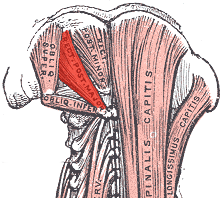Rectus capitis posterior major muscle
The Rectus Capitis Posterior Major muscle is a small muscle located at the back of the neck. It is one of the deep muscles of the suboccipital region, along with the Rectus Capitis Posterior Minor, Obliquus Capitis Superior, and Obliquus Capitis Inferior muscles. In this article, we will explore the anatomy, function, and clinical significance of the Rectus Capitis Posterior Major muscle.
Anatomy[edit | edit source]
The Rectus Capitis Posterior Major muscle originates from the spinous process of the axis (C2) vertebra, which is the second cervical vertebra. It then inserts onto the lateral part of the inferior nuchal line of the occipital bone, which is the bony ridge at the base of the skull.
The muscle is innervated by the suboccipital nerve, which is a branch of the dorsal ramus of the first cervical nerve (C1). The blood supply to the Rectus Capitis Posterior Major muscle is provided by branches of the occipital artery.
Function[edit | edit source]
The main function of the Rectus Capitis Posterior Major muscle is to extend the head at the atlanto-occipital joint. This means that it helps to tilt the head backward, as if looking up towards the ceiling. Additionally, it also assists in rotating the head to the same side.
Clinical Significance[edit | edit source]
The Rectus Capitis Posterior Major muscle can be involved in various clinical conditions, including:
- 1. Suboccipital headache: Dysfunction or tension in the suboccipital muscles, including the Rectus Capitis Posterior Major, can lead to headaches localized at the back of the head. These headaches may be accompanied by neck pain and restricted range of motion.
- 2. Whiplash injuries: In cases of whiplash, where the head is forcefully thrown forward and backward, the Rectus Capitis Posterior Major muscle can be strained or injured. This can result in pain, stiffness, and limited movement of the neck.
- 3. Cervical spine disorders: Dysfunction of the cervical spine, such as cervical spondylosis or herniated discs, can affect the Rectus Capitis Posterior Major muscle. This can lead to muscle imbalances, pain, and restricted neck movements.
Related Muscles[edit | edit source]
The Rectus Capitis Posterior Major muscle is closely related to other muscles in the suboccipital region. These include:
- 1. Rectus capitis posterior minor: This muscle lies just anterior to the Rectus Capitis Posterior Major and has a similar function of extending and rotating the head.
- 2. Obliquus capitis superior: Located above the Rectus Capitis Posterior Major, this muscle also contributes to head extension and rotation.
- 3. Obliquus capitis inferior: Positioned below the Rectus Capitis Posterior Major, this muscle assists in head rotation and lateral flexion.
References[edit | edit source]
- 1. Drake, R. L., Vogl, W., & Mitchell, A. W. (2014). Gray's anatomy for students. Elsevier Health Sciences.
- 2. Standring, S. (Ed.). (2016). Gray's anatomy: the anatomical basis of clinical practice. Elsevier Health Sciences.
See Also[edit | edit source]
| Muscles of the neck | ||||||||||
|---|---|---|---|---|---|---|---|---|---|---|
|
Search WikiMD
Ad.Tired of being Overweight? Try W8MD's physician weight loss program.
Semaglutide (Ozempic / Wegovy and Tirzepatide (Mounjaro / Zepbound) available.
Advertise on WikiMD
|
WikiMD's Wellness Encyclopedia |
| Let Food Be Thy Medicine Medicine Thy Food - Hippocrates |
Translate this page: - East Asian
中文,
日本,
한국어,
South Asian
हिन्दी,
தமிழ்,
తెలుగు,
Urdu,
ಕನ್ನಡ,
Southeast Asian
Indonesian,
Vietnamese,
Thai,
မြန်မာဘာသာ,
বাংলা
European
español,
Deutsch,
français,
Greek,
português do Brasil,
polski,
română,
русский,
Nederlands,
norsk,
svenska,
suomi,
Italian
Middle Eastern & African
عربى,
Turkish,
Persian,
Hebrew,
Afrikaans,
isiZulu,
Kiswahili,
Other
Bulgarian,
Hungarian,
Czech,
Swedish,
മലയാളം,
मराठी,
ਪੰਜਾਬੀ,
ગુજરાતી,
Portuguese,
Ukrainian
Medical Disclaimer: WikiMD is not a substitute for professional medical advice. The information on WikiMD is provided as an information resource only, may be incorrect, outdated or misleading, and is not to be used or relied on for any diagnostic or treatment purposes. Please consult your health care provider before making any healthcare decisions or for guidance about a specific medical condition. WikiMD expressly disclaims responsibility, and shall have no liability, for any damages, loss, injury, or liability whatsoever suffered as a result of your reliance on the information contained in this site. By visiting this site you agree to the foregoing terms and conditions, which may from time to time be changed or supplemented by WikiMD. If you do not agree to the foregoing terms and conditions, you should not enter or use this site. See full disclaimer.
Credits:Most images are courtesy of Wikimedia commons, and templates, categories Wikipedia, licensed under CC BY SA or similar.
Contributors: Prab R. Tumpati, MD




